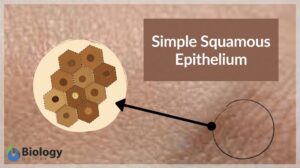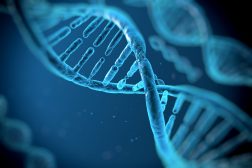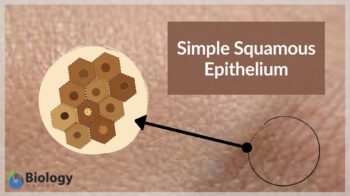
Squamous epithelium
n., plural: squamous epithelia
[ˈskweɪ.məs ˌɛpɪˈθiːlɪəm]
Simple epithelium composed of squamous epithelial cells
Source: Maria Victoria Gonzaga, BiologyOnline.com
Table of Contents
Simple Squamous Epithelium Definition
Simple squamous epithelium, also known as simple squamous epithelial tissue or pavement epithelium, is an epithelial tissue that is composed of a single layer of epithelial cells. The term ‘pavement epithelium’ comes from its tile- or brick-like appearance. The epithelial tissue is in direct contact with the basement membrane that separates it from the underlying connective tissue. This basement membrane acts as a cement to ‘pin’ the epithelial tissue to the underlying structures.
Epithelial cells are sheets of cells that are found lining almost all surfaces in the body. They can be described as either simple (single layer) or compound/stratified (multiple layers) and may be classified histologically according to the shape of the cells it is made up of. It may be squamous (scale-like), cuboidal (cube-like), or columnar (column-like).
Simple squamous epithelium is a type of simple epithelium made up of squamous epithelial cells that lines the outer layer of the skin, endothelium, and secretory parts of the small glands. It also lines the glomeruli in the kidney and the pulmonary alveoli where passive diffusion occurs. Synonyms: simple squamous epithelial tissue; pavement epithelium.
Simple Squamous Epithelium Characteristics
A simple squamous epithelium is a simple epithelium made up of squamous epithelial cells. The squamous epithelial cells are characterized by being flat, possessing an oblong nucleus, and having a scale-like appearance. The cells are wider than they are tall and appear somewhat hexagonal when viewed from above.
Figure 1 shows a diagram of simple squamous epithelium labeled. The tissue is polarized with one surface that faces the external environment, and the other that faces the basement membrane. This type of epithelium provides a smooth, low-friction surface, and thereby allows easy movement of fluids over it. It is often permeable allowing small molecules to pass through the membrane via diffusion or filtration.
Blood vessels are not in direct contact with the epithelial cells and therefore they gain all their nutrients such as oxygen and metabolites through diffusion. Thus, the basement membrane provides a vital role allowing diffusion of important nutrients across it and into the simple squamous epithelium. Epithelial cells have receptors known as integrins on their cell membrane allowing them to interact with the basement membrane.
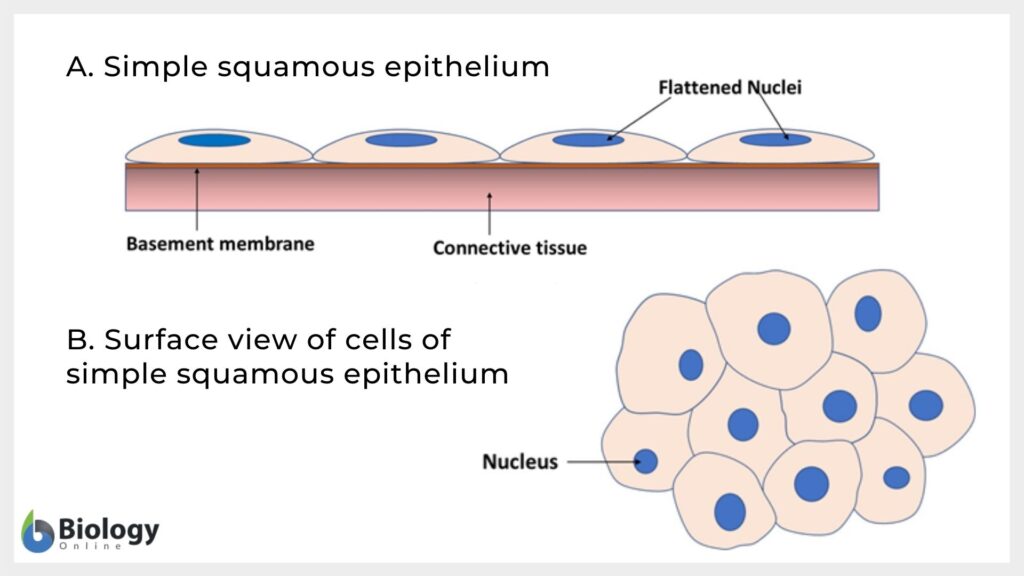
Cell Structure and Histology
The simple squamous epithelium is a single, flat layer of cells. The cells are tightly packed together due to pressure, giving them a polygonal arrangement. Figure 2 shows an example of a simple squamous epithelium slide. The cells can be seen rolled up to form tubes, as is the case with blood capillaries of the vascular system allowing the exchange of nutrients and waste (Figure 3).

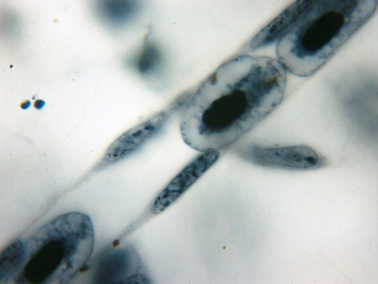
The basement membrane below the simple squamous cells consists of 2 layers, the basal lamina, and the reticular lamina. The basal lamina consists of glycoproteins and collagen and it functions as the attachment site to the epithelium. The basal lamina is attached to the reticular lamina which is secreted by the connective tissue layer below.
Simple Squamous Epithelium Function
What is the function of simple squamous epithelium? The simple squamous tissue is mainly involved in secretion and absorption. Because they have a thin and simple construction, they allow small molecules to move easily across the membrane. For example, oxygen and carbon dioxide diffuse across the membrane according to a concentration gradient. They also possess transmembrane protein channels to allow certain molecules across the cell.
The diversity of these transmembrane channels allows the differentiation of the simple squamous tissue to serve its purpose depending on its location in the body. It is also worth noting that epithelial cells, in general, are usually situated on the outside of tissues, next to a lumen or ‘inside space’. This also gives it the added role of protecting the underlying tissue from the outside environment.
Simple Squamous Epithelium Location
Where is simple squamous epithelium found? There are different locations of simple squamous epithelium. They are found throughout the body, for example on the inner surface of lymphatic and blood vessels and lining the glomerulus and bowman’s capsules in the kidney. They serve as the lining of the pericardial, peritoneal, and pleural cavities as well as lining the alveoli of the lungs in which it allows the diffusion of gases. They also cover the female and male reproductive cavities.
The simple squamous epithelial cells that line the body cavities, reproductive organs, and heart are known as the mesothelium. The endothelium is the term given to squamous epithelium that lines the inner surface of blood vessels and lymphatic vessels. The structure and functions of the mesothelium and the endothelium are explained in more detail below.
Examples of Simple Squamous Epithelia
In the Kidney
Blood is filtered between the squamous epithelial cells in the glomerular capillaries and the squamous epithelial cells of the bowman’s capsule. Urine is formed by the secretion, absorption, and reabsorption that occurs between these cells.
In the Lungs
Simple squamous epithelium lining the alveoli in the lungs allows the gas exchange between the alveoli and the blood vessels while also forming a barrier between the outside and the internal body fluids.
Simple squamous epithelium can be further explained depending on its location in the body:
Mesothelium
The Mesothelium is found on the surface of all coelomic organs (body cavity). Mesothelial cells were first described by Xavier Bichart in 1827. The term mesothelium followed later in 1890 by Minot after studying these cells in detail.
Mesothelial cells originate from the mesoderm, one of three primary germ layers in early embryonic development. The other 2 layers are the ectoderm or ‘outside layer’ and the endoderm or ‘inside layer’. The mesothelium is composed of 3 layers. A monolayer of mesothelial cells, the basement membrane below, then the sub mesothelial connective tissue which contains fibroblasts, blood, and lymph vessels, inflammatory cells, collagen, and adipose tissue as well as nerve bundles. Figure 4. shows the structure of the mesothelium in detail.
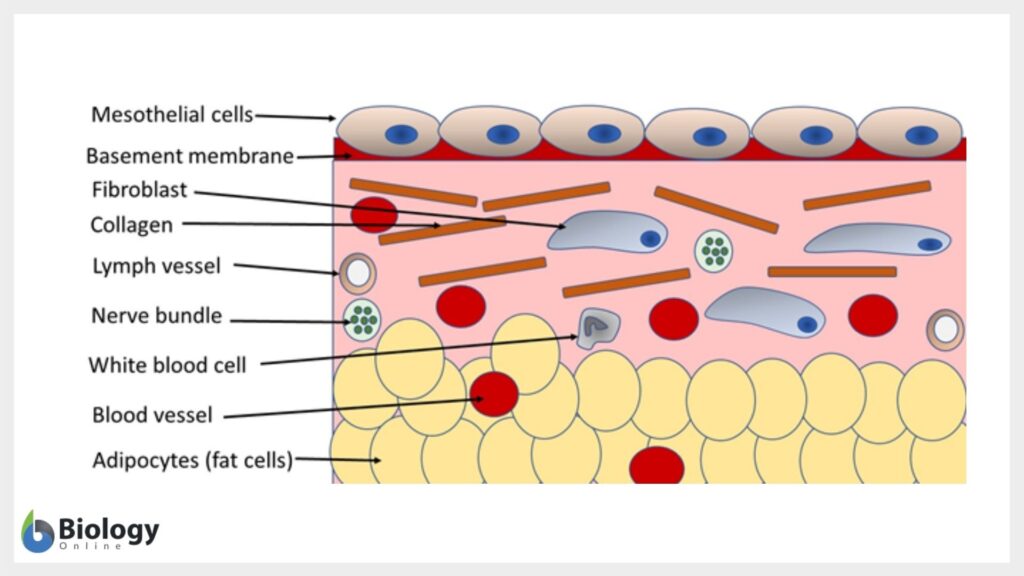
Mesothelial cells also have microvilli on their surface. These are non-motile projections that help to increase the surface area and absorption of nutrients. The microvilli secrete a lubricant known as a glycocalyx which is made up of glycosaminoglycans (GAGs). This lubricant limits fluid loss by binding to fluid and aiding absorption. It is also known to protect against infection and the formation of tumors.
Between mesothelial cells are strong cell-cell junctions consisting of tight junctions, gap junctions, and desmosomes. The tight junctions allow diffusion and maintain cell surface polarity. Adherin junctions provide structural and adhesive support. Gap junctions contain a cluster of channels that allow cell-cell transport of molecules in solution. Finally, desmosomes help maintain the integrity of the tissue structure by acting as an adhering spot.
The pleural mesothelium consists of 2 types of mesothelium. Encasing the cavity walls, it is called the parietal pleura, whereas covering the surface of the lungs, it is called the visceral pleura. The cardiac mesothelium on the other hand is associated with the heart. Where it covers the pericardial cavity, it is known as the parietal pericardium. The visceral (inner) mesothelium on the heart surface is the epicardium. Finally, the serosal mesothelium is found in the gut, on the visceral layer of the peritoneum.
Inflammation can develop in the mesothelium. Mesothelial cells can proliferate and release inflammatory mediators such as cytokines and prostaglandins. Malignant mesothelioma is a cancer of the mesothelium in which the mesothelium becomes abnormal. They are considered malignant due to the potential of the cells to spread to other surrounding tissues and parts of the body (Metastasize). This type of cancer is associated with asbestos exposure.
Accumulation of fluid between the mesothelium layers is a symptom of this disease leading to inflammation. This indicates the importance of the mesothelial cells in regulating inflammation.
Endothelium
Endothelial cells control the passage of materials and the movement of white blood cells. The endothelium is thought to have a wide range of functions. These include blood fluidity, vascular tone, platelet aggregation, and regulation of inflammation. It is also important for metabolism and the endocrine system. Furthermore, new blood vessels can develop from existing ones by the outgrowth of endothelial cells. This creates new tubes and is termed angiogenesis. The endothelium is an important regulator of vascular homeostasis, that is, the regulation of vascular injury and repair.
Blood vessels can be described as having 3 different layers. The first is the tunica intima, which is a single layer of endothelial cells, the second is the tunica media, which is made up of vascular smooth muscle cells. Finally, and the third layer is the tunica externa, which includes connective tissue such as fibroblasts, mesenchymal stem cells, lymph vessels, and nerve bundles. In arteries, a thicker tunica media layer is produced due to the added pressure of blood flowing through them, in smaller capillaries, only a tunica intima layer is found with a basement membrane and pericytes, which help to regulate blood flow. Figure 5. shows the structure of the blood vessels with the various layers.

Types of Simple Epithelium: similarities and differences
There are 4 types of simple epithelial tissue. These are simple squamous epithelium, simple cuboidal epithelium, simple columnar epithelium, and pseudostratified epithelium. Epithelial tissue is described using 2 words, the first describes the number of layers, the second describes the shape. So ‘simple squamous’ means a single layer of flattened cells. The text below and figure 5. show the main points of each type of simple epithelium.
Simple Squamous Epithelium
Simple squamous epithelial cells are flat and thin enough to allow molecules to pass via diffusion. This cell type is found in the walls of capillaries, linings of the pericardium, and alveoli.
Simple Cuboidal Epithelium
Simple cuboidal epithelial cells on the other hand are tall cells and look cuboidal in shape. They are involved in secretion and absorption. These cells can be found in the collecting ducts of the kidneys, in the salivary glands as well as the pancreas.
Simple Cuboidal Epithelium
Simple columnar epithelial cells are tightly packed tall cells. They are found in the lining of the stomach, and the small intestine. They are also found in the lining of the female reproductive tract. They have an important secretory role and may possess microvilli (as found in the small intestine) or cilia (as found in the female reproductive tract).
Pseudostratified Epithelium
Finally, pseudostratified epithelial cells are columnar epithelial cells that have nucleoli at varying heights giving the illusion of layers when in fact they are a single layer. They may contain cilia (as found in the nose and bronchi, uterus, and fallopian tubes). This is called the ciliated pseudostratified epithelium.
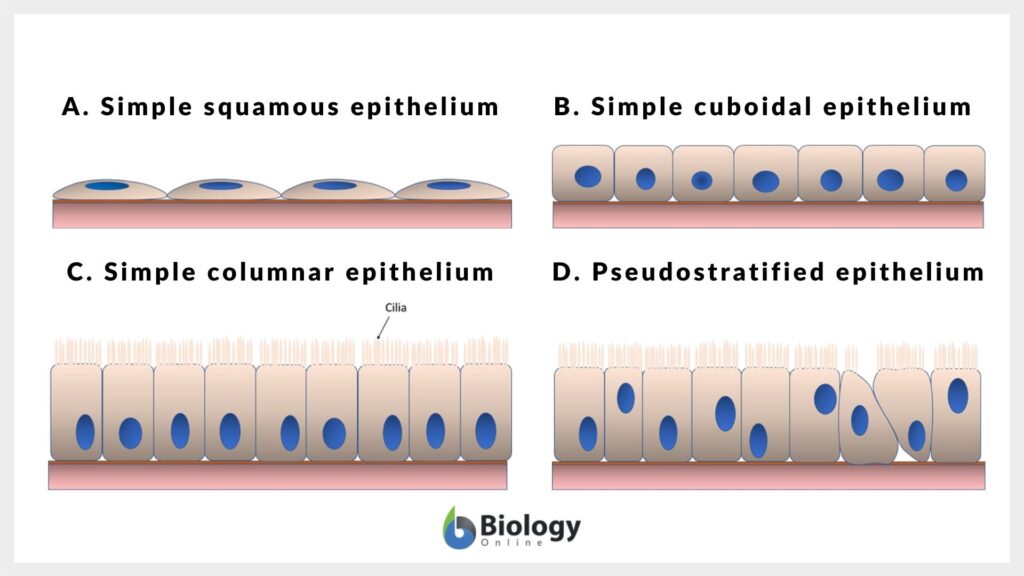
Conclusion
Overall, simple squamous cells function to provide protection, secretion, diffusion, and filtration. Mesothelial cells are an example of simple squamous epithelial cells that form the serous membrane lining internal organs and body cavities protecting them by secreting a lubricating fluid. Endothelial cells are another example of specialized simple squamous epithelium, allowing the exchange of gases across the blood vessels. The roles these cells play are complex, and they express and produce different proteins based on their locations.
Try to answer the quiz below to check what you have learned so far about simple squamous epithelium.
References
• Alberts, B., Johnson, A., Lewis, J., et al. 2002. Blood Vessels and Endothelial Cells. Molecular Biology of the Cell. 4th edition. New York: Garland Science; Available from: https://www.ncbi.nlm.nih.gov/books/NBK26848/
• BCCampus Epithelial tissue. Anatomy and physiology. (4) 4.2. https://opentextbc.ca/anatomyandphysiology/chapter/4-2-epithelial-tissue/
• Boundless.com. 2020. Types of Epithelial Tissue. Medicine Libretexts. https://med.libretexts.org/Bookshelves/Anatomy_and_Physiology/Book%3A_Anatomy_and_Physiology_(Boundless)/4%3A_Organization_at_the_Tissue_Level/4.2%3A_Epithelial_Tissue/4.2B%3A_Types_of_Epithelial_Tissue#:~:text=Simple%20epithelial%20tissues%20are%20generally,columnar%3B%20and%204)%20pseudostratified
• Davidson College Biology Department. (2010). Simple Squamous Epithelium. Epithelial cells. https://www.bio.davidson.edu/people/kabernd/berndcv/lab/epithelialinfoweb/Simple%20Squamous%20Epithelium.html
• Epithelia Lab. Systems Cell Biology at Yale. http://medcell.med.yale.edu/systems_cell_biology/epithelium_lab.php
• Epithelial tissue. Lumen, Boundless Anatomy and Physiology. https://courses.lumenlearning.com/boundless-ap/chapter/epithelial-tissue/
• Félétou M. (2011). The Endothelium: Multiple Functions of the Endothelial Cells. Part 1: Multiple Functions of the Endothelial Cells—Focus on Endothelium-Derived Vasoactive Mediators. San Rafael (CA): Morgan & Claypool Life Sciences. Chapter 2. https://www.ncbi.nlm.nih.gov/books/NBK57148/
• Hiriart, E., Deepe, R., & Wessels, A. (2019). Mesothelium and Malignant Mesothelioma. Journal of developmental biology, 7(2), 7. https://doi.org/10.3390/jdb7020007
• Kawanishi K. (2016). Diverse properties of the mesothelial cells in health and disease. Pleura and peritoneum, 1(2), 79–89. https://doi.org/10.1515/pp-2016-0009
• Neville, B.W., Damm, D.D., Allen, C.S., Chi, A.C. 2019. Epithelial Pathology. Color Atlas of Oral and Maxillofacial Diseases. (10) 223-271. https://doi.org/10.1016/B978-0-323-55225-7.00010-5
• McMillan, D.B., Harris, R.J. 2018. Epithelial tissues. An Atlas of Comparative Vertebrate Histology. 45-74. https://doi.org/10.1016/B978-0-12-410424-2.00003-2
• Mutsaers, S. 2002. Mesothelial cells: Their Structure, Function and Role in serosal repair. Respirology. (7) 171-191.
• Mutsaers S.E., Herrick, S.E. 2006. Mesothelial cells. Encylopedia of Respiratory Medicine. 47-52. https://doi.org/10.1016/B0-12-370879-6/00246-5
• Selby, K. What is the Mesothelium. Asbestos.com. https://www.asbestos.com/mesothelioma/causes/mesothelium/#:~:text=Inflammation%2C%20scarring%20and%20cancer%20can%20develop%20in%20the%20mesothelium.&text=Effusions%2C%20or%20the%20accumulation%20of,diseases%2C%20not%20a%20primary%20disease.
©BiologyOnline. Content provided and moderated by BiologyOnline Editors.

